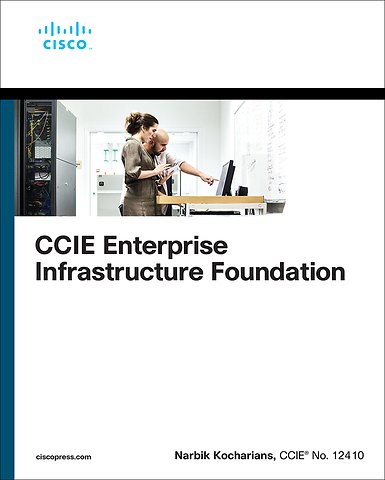CCIE Enterprise Infrastructure Foundation
Paperback Engels 2022 9780137374243Samenvatting
Recent changes to Cisco certification make it crucial for experienced network professionals to bridge the gap between CCNP Enterprise Core (350-401 ENCOR) knowledge and the deep hands-on expertise they need to succeed with their CCIE labs. In CCIE Enterprise Infrastructure Foundation, Cisco instructor Narbik Kocharians helps students make this leap with confidence. Based on the author's industry-recognized CCIE prep classes, this progressive learning tool brings together:
40+ detailed labs for real gear and platform emulators Structured illustrations of protocol and feature operation Topic-specific labs to drive the theory home A full lab walkthrough of a complex configuration reflective of the actual CCIE
Following the same pattern as the authors' previous book, CCIE Routing and Switching V5.1 Foundations, this guide covers both mature technologies and today's increasingly critical policy-based, intent-driven solutions. Step by step, students will learn how to:
Discover the physical topology for any network deployment Work with Spanning Tree Protocol (STP): both its foundations and advanced features Deploy and optimize PPP and use its full set of capabilities Implement Dynamic Multipoint VPNs (DMVPNs) from start to finish Use IP Prefix lists in prefix filtration, packet filtering, and other applications Handle any RIPv2 deployment scenario n Implement EIGRP, including classical and named operation modes and interoperation Use advanced OSPF techniques, including route filtration, LSA operation, stub configurations, and update filtering Understand what happens when you perform redistribution, and manage problematic scenarios Manage complex BGP capabilities, including Adjacency State Machine Operate IPv6 in complex network environments, including DMVPN Focus on QoS mechanisms that CCIE still covers, including traffic marking, classification, policing, and shaping Deploy IPsec VPN solutions including GRE/IPSec tunnel mode, multi-site VPN technologies, and their encryption Implement multicasting in environments requiring end-to-end IPv4 and IPv6 transport Address operational and deployment issues involving MPLS VPNv4 tunnels
By the time they're done, students will thoroughly understand these Cisco technologies and interactions, and be comfortable applying theory in any real-world environment – and especially on CCIE labs.
Specificaties
Lezersrecensies
Inhoudsopgave
Rubrieken
- advisering
- algemeen management
- coaching en trainen
- communicatie en media
- economie
- financieel management
- inkoop en logistiek
- internet en social media
- it-management / ict
- juridisch
- leiderschap
- marketing
- mens en maatschappij
- non-profit
- ondernemen
- organisatiekunde
- personal finance
- personeelsmanagement
- persoonlijke effectiviteit
- projectmanagement
- psychologie
- reclame en verkoop
- strategisch management
- verandermanagement
- werk en loopbaan
